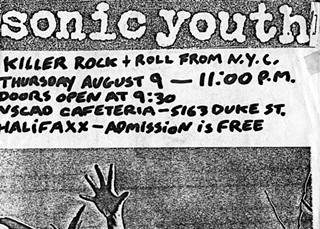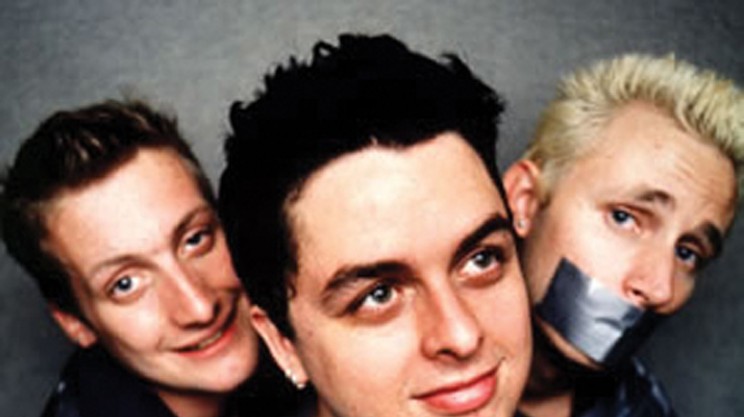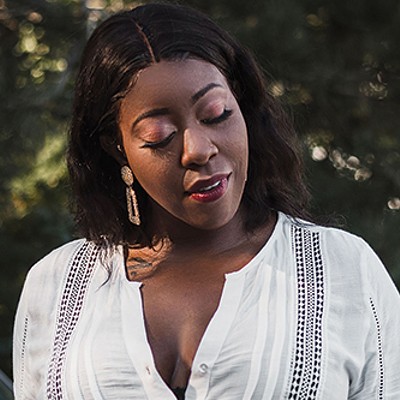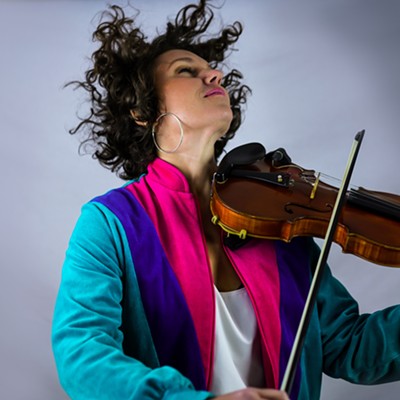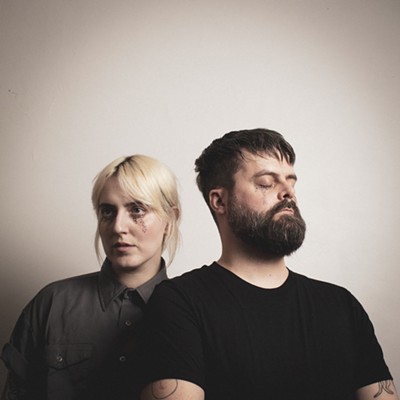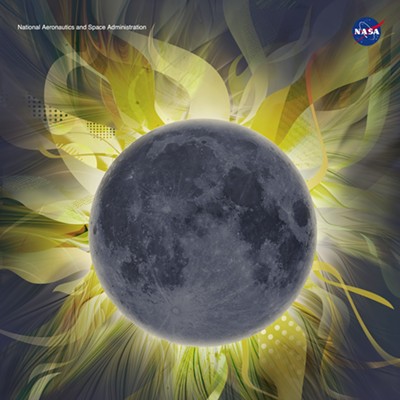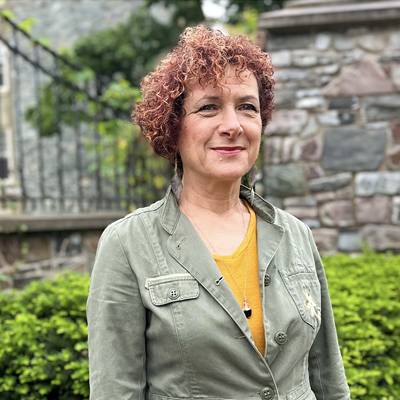The Khyber ICA is steaming hot, packed with bands and fans for the Totally Wicked Music Festival, a one-night music event where bands come together for one night and play one song each. The first Totally Wicked Music Festival happened 10 years prior---an idea born on the NSCAD campus after an Anna Leonowens exhibition opening, when comic artist Marc Bell started rhyming off bad band names. Rat Salad and The Shitty Fucking Shut-Ups played that first time, as did Irene Goes Domestic, which helped propel artist Eleanor King (The Just Barelys, The Got To Get Got) toward music.
King organized this year's festival, which included fleeting performances from bands like Caramel Axe and Craig (which included music-minded artist and NSCAD faculty member Craig Leonard). There were some really great bands. So good in fact, it seems a shame that they only lasted for about five minutes each. But that's the fleeting nature of performance art.
September 2006
A small crowd gathers outside around the window next to the old Eyelevel Gallery space on Gottingen Street. A small drum kit and amp are loaded into the closet-sized storefront. It's not large enough to accommodate the three musicians jammed into the space---Dave Ewenson barely has room for his elbows, let alone his saxophone, and Selwyn Sharples' long limbs give the instrumental performance an Alice in Wonderland "drink me-eat me" vibe. Sharples switches between guitar and drums with Dweebo (Mitchell Wiebe), a creature in a white suit and marshmallow-shaped headpiece that is somehow a cross between a nuclear-radiated fly, chemically mixed with a featherless eagle.
The crowd is clearly entertained by the musical spectacle: drinking beer out of plastic cups, tapping feet, carrying on conversations. No one thinks this is strange. These people are used to---some are trained in and expect---performance. But if you want to blame this apparition on something, if you need a root cause, look no further than the Victorian-era stone buildings that dominate Duke Street. Blame NSCAD University.
According to Dr. Jacqueline Warwick, Dalhousie University's popular musicology expert and associate professor, the links between art schools and music production are older and broader than the tiny Gottingen window. John Lennon met original Beatle Stuart Sutcliffe at the Liverpool College of Art---part of the same Liverpool Institute where Paul McCartney (who now enjoys a second career as a painter) and George Harrison attended. After being expelled, Rolling Stone badass Keith Richards was sent to Sidcup Art School, outside of London. Charlie Watts trained as a commercial artist and Ron Wood's time at Ealing Art College hasn't gone to waste---his rock 'n' roll autobiographical drawings, prints and paintings are exhibited around the world.
In sound, NSCAD's art-school music scene has less to do with these old British dudes than it does with the American art-school punk of the 1970s. Bands like Devo formed at Kent State University's art program in 1972, and Talking Heads began playing in 1977 at the Rhode Island School of Design. "These are bands that took a certain arty stance on what they were doing with their music," says Warwick. "Their presentation was ironic, campy and certainly trying to make some sort of comment on the society they lived in. You could almost call it a political statement."
Dweebo's suit might offer the same chemical protection as Devo's yellow garb, and Wiebe's stage presence (when not suited up) with band Soaking Up Jagged has the same spastic visual appeal as Heads' frontman, David Byrne. Wiebe, a 1996 NSCAD MFA grad, often shares artistic training with his bandmates, including SUJ's Rebecca Young, who now works in the school's library. Wiebe's previous band City Field included Sarah Gregg Millman (BFA 2002), whose video work has exhibited around the world.
Warwick says that's not surprising. She thinks more pop music tends to come out of art studios than out of music school conservatories, in part, because of an openness to experiment, a recognition of how instruments can act as art objects, and a lack of fear of sounding like shit sometimes.
For instance, it's hard to imagine degree-toting Diana Krall (Berklee College of Music) wearing figure skates and playing violin on a block of melting ice, like multidisciplinary demi-god Laurie Anderson did in the 1970s.
"So many bands form, and have that real punk attitude---we'll just pick up instruments and figure it out as we go along. Whether or not the musical result is what we would call punk---they have that approach in the beginning," says Warwick, who finds the vitality of our regional music scene a very positive sign, especially in an era dominated by mass marketing of international pop stars. "There's obviously something going on in that art school world, the encouragement to experiment and try new things, and try new ways of self-expression."
Lukas Pearse is one of those rare birds who has both art and music degrees hanging on his wall. He began playing in Halifax clubs like the now-defunct Flamingo well before he was legally allowed to drink beer. After graduating from NSCAD where he focused on sound, installation and photography, Pearse started playing double bass for the indie trio Rebecca West in 1994.
Like other bands from the Halifax '90s heyday such as Jale and Sloan who had band members who were art grads or students, Rebecca West played to appreciative NSCAD audiences.
"NSCAD always provided a venue for more experimental bands and a more appreciative audience who want things to be more experimental than they want them to be entertaining, I'd venture," Pearse says, suggesting that audience enthusiasm makes up for the lack of decent live music venues on campus. "They want it to be different than what they hear on the radio."
Pearse, who also did an undergraduate music degree at Dalhousie and a master of contemporary music studies at Goldsmiths College in London, UK, has taken a decidedly different route than his comrades from the day, as an active member in the city's "really small experimental scene," which exists outside of the NSCAD pop focus.
As he crosses over between music scenes---he calls it bilingualism---Pearse has observed a broad disconnect between Halifax's experimental music performers, NSCAD's creative pop-stylers and Dalhousie's classically trained musicians---and all of them think they're "the scene."
He says this isn't the case everywhere. A couple of years ago, Pearse performed in Berlin at Emerson Gallery, at their Summer Festival of Canadian Arts, along with Theatre DaPoPo, amongst visual art installations by Cathy Busby and Garry Neill Kennedy. The concert was attended by what he referred to as a "fine art new music crowd."
"Things that seem really experimental in Halifax that people avoid---it just seems too weird," says Pearse, "or seems like, 'Why would you want to do that, it's probably fun to do participate in, but why would you want to listen to it'---in Europe, you actually get audiences. It's not that people there are weirder, they see it as 'Oh, it's one of those.'"
August 9, 1984
Perhaps everyone was thinking it was "too weird" that infamous night, when Sonic Youth, a band built inside a snow-globe of orchestra, avant-garde music and punk, played the NSCAD cafeteria, banging on garbage cans, to a very, very small audience (actual numbers vary, depending on the source).
"Has anyone mentioned Sonic Youth in the cafeteria yet?" Jason MacIsaac laughs, as if he already knows the answer to the question. Two of his former Heavy Blinkers bandmates, co-writer and producer Andrew Watt and singer Ruth Minnikin, trained at NSCAD. (Although the Blinkers are currently inactive, there's a long-awaited album still in the works, and Spin recently declared them one of the "best bands you've probably never heard.") Watt, says MacIsaac, put his design training to good use in developing the Blinkers' "imagery and the branding." Together with Blinker Greg Fry, they storyboarded the band's first animated video for "You Can Heal," and designed most of the band's posters.
MacIsaac observes the flair for the theatrical in many NSCAD-based bands, but not as much in Minnikin, whose last album arrived in a lovely autumn-inspired, screen-printed canvas CD case that she designed. "When she writes, it's very organic and plain-song and rustic, you wouldn't expect that at all out of an art student, especially when you see the graphic work she does," says MacIsaac. "There's nothing to suggest she would be that type of artist. It's born out of being in direct opposition of her visual teaching that the music is radically different."
It's perhaps in the promo materials---album artwork, t-shirts, posters---where NSCAD's influence is most dramatically recognizable in this town. Thanks to the printed-matter stylings of designers like Yo Rodeo raising the artistic bar (a clever mix of fantastical vintage imagery with a distinctive modern feel), band posters get snatched up by avid collectors. Of course, Yo partners are both musicians---Paul Hammond used to be in Sharp Like Knives and Seth Smith plays with pop favourite Dog Day.
In 2006, about six months before her first full-length album, Orchestra for the Moon, made her the cross-country darling we all now know and love, Jenn Grant spoke about the pressures for artist-musicians to "represent" their school. "I feel like I should do something good for sure---mostly I want to impress [instructor] Michael Fernandes."
The singer graduated from NSCAD with a fine arts degree (she painted the artwork on both her full-length albums).
"I did ceramics for a year---I wasn't very good---but my teacher said that everything I did was really musical," she says. "For me, whenever I have a song and a painting, there's a lot of juxtapositions and they're colourful, and don't generally follow the regular structures of anything. The way that I go about it is really loose and energetic in both."
For Grant, art school was the best way to overcome her shyness about being on stage. "It was a way for me to express myself and be happy, to share my feelings without people looking at me---just look at my finished pieces. But now I'm happy with the stage performances."
If there's one thing NSCAD musicians know about, it's the importance of performance. Lukas Pearse says the school's focus on performance art has led to a self-awareness of performance as a type of artistic expression that's separate from the lyrics or guitars riffs. It's a legacy that had its place with older bands like The Confidence Band. It started in 1997, with artist Matt Reid and iconic, Governor General Award-winning artist/professor Rita McKeough, who had performed in many punk projects since the 1980s. That spirit continues with the newer generation of NSCAD bands like roomdoom, who recently collaborated in performance with artist Jason Johnson.
"You can stand there and play your instruments, or you can make it a show. And the performance can be ridiculous and not a Metro Centre-type of show, but just weird. I think that's part of the legacy of NSCAD," says Pearse. "There's an awareness they're putting on a show and they're doing it with a wink and a smile."

